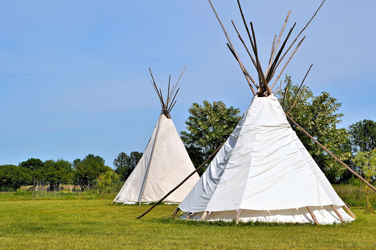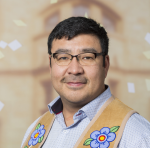I’m from kâniyâsihk, which means “a point” in Cree. This particular point is located on Ministikwan Lake in Saskatchewan, where I grew up and still live. The boreal forest is extremely beautiful, and is home to amazing lakes as well as various animal and bird sanctuaries.
As a researcher, I’ve studied teaching methodologies, teacher training programs and environmental education in an effort to improve the education in my community. For over 15 years, I’ve worked with community schools to promote education that focuses on the land and the Cree language. Let me tell you a bit about the revitalization efforts I’ve been involved in.
kâniyâsihk Culture Camps
At Ministikwan Lake, we launched a group initiative that could inspire other communities to do the same. In 2000, we found that there was a disconnection—a communication breakdown—between our elders and our children. Our own Indigenous dialect, Plains Cree, was not being spoken by many children at school or in the community, which made it very difficult for our elders to pass on their Indigenous knowledge.
We also noted a disconnection with the land. For example, the annual harvesting of medicinal plants and wild foods, such as edible berries, was becoming an endangered tradition. We were so rich in culture and resources that this disconnect had gone unnoticed. But when the elders and knowledge keepers were no longer connecting with the younger generations, it was alarming to enough of us to take action. As community members and family members, we decided to create a space where we could not only share our knowledge and language but also learn from other Indigenous nations of the world. We created kâniyâsihk Culture Camps (opens in new tab), a non-profit organization focused on the holistic well-being of the community. It is a gathering place for elders to pass on their knowledge and teach our youth about our ancestral customs. It is also a place to commune with nature, paddle on the lake in the summer, go dog sledding in the winter and return to the heart of Cree culture by speaking the language and making connections. More than 16 years later, we’re proud to say that kâniyâsihk Culture Camps have been a real success.
Cree immersion school
The success of the kâniyâsihk Culture Camps encouraged us to launch a program for the students in our community: kâ-nêyâsihk mîkiwâhpa, a land-based Cree immersion school.
We started the Cree immersion school in response to a community survey designed to determine the importance of our language and culture. The survey revealed an overwhelming need to preserve, revitalize and normalize our language. This drove us to determine how much time students were spending speaking Cree at school and to closely examine the education curricula. We discovered that the curricula were not representative of any Indigenous knowledge. Rather, they were very Eurocentric.
It was clear that we needed a program that would allow us to impart our ancestral knowledge, preserve our traditional culture and revitalize the Cree language. Our immersion school allows our community teachers, who are all fluent in Cree, to use their skills and teach in their own dialect. It is a place where First Nations perspectives are explained and students are dedicated to learning.
Inspiration for the future
I hope to inspire others to implement their own cultural revitalization initiatives. Such programs provide opportunities for Indigenous youth to develop traditional skills, learn about their native culture and speak their ancestral language. But more importantly, these types of programs allow younger generations to reconnect with their elders, who have a wealth of knowledge to pass on.
If you know of another Indigenous revitalization project, tell me about it in the comments sections below.

